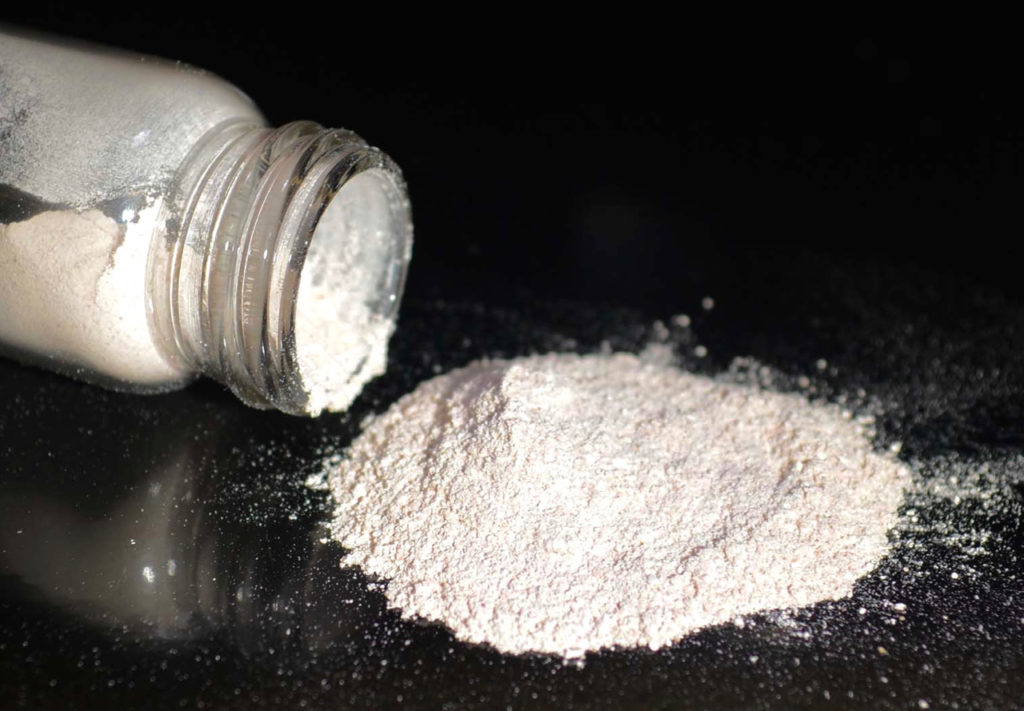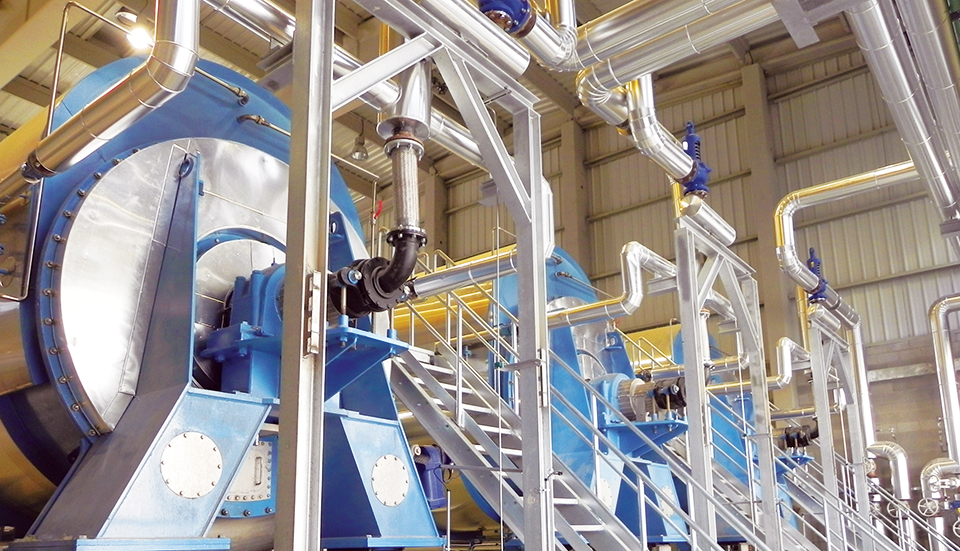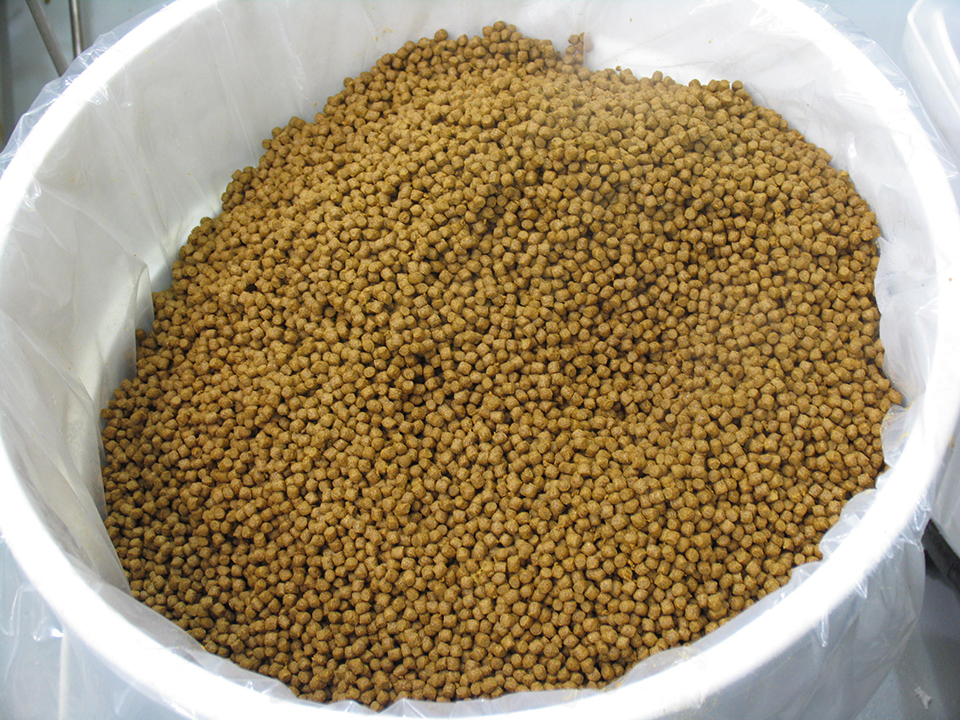Potassium permanganate and peroxide compounds used mainly as disinfectants

A number of oxidants are used in aquaculture, including chlorine compounds such as calcium hypochlorite, potassium permanganate, hydrogen peroxide, sodium carbonate peroxyhydrate, calcium peroxide and sodium nitrate.
These chlorine compounds are used mainly as disinfectants. Potassium permanganate and peroxide compounds are used as disinfectants and for treating external fungal and bacterial infections on eggs and fish – usually in hatcheries, but sometimes in ponds. Potassium permanganate, peroxide compounds and sodium nitrate also are sometimes used as water quality enhancers.
Potassium permanganate
Potassium permanganate has been promoted as a means of oxidizing organic matter in ponds and thereby lessening the oxygen demand and increasing the dissolved-oxygen concentration. However, research conducted at Auburn University and other research stations has found that potassium permanganate treatment often kills phytoplankton and can actually lead to lower dissolved-oxygen concentrations.
Under certain conditions, potassium permanganate can be used to remove hydrogen sulfate and ferrous iron from water supplies for hatcheries and from pond water. The amounts of potassium permanganate required for removing 1 mg/L of hydrogen sulfide or ferrous iron are 6.19 and 0.94 mg/L, respectively. Aeration usually is a more effective and cheaper method for removing hydrogen sulfide and ferrous iron from water. Overall, potassium permanganate is not a useful water quality enhancer.
Sodium nitrate
Sodium nitrate is used as a fertilizer to encourage diatoms in shrimp ponds. Although it is sometimes claimed to increase dissolved-oxygen concentrations in water, this compound does not release molecular oxygen. Rather, it serves as a source of oxygen for denitrifying bacteria that reduce nitrate to gaseous nitrogen. While a measurable concentration of nitrate remains in water or sediment, the redox potential will be too high for production of ferrous iron and hydrogen sulfide by anaerobic bacteria.
Sodium nitrate can be beneficial to water quality in ponds, but it is expensive, and the economic benefits of its use have not been carefully studied. Nitrate compounds such as potassium, calcium and ammonium nitrate behave chemically in the same manner as sodium nitrate, but only sodium nitrate has been used widely as a sediment oxidant.
Hydrogen peroxide
Hydrogen peroxide often has been added to water in tanks used to transport fish fingerlings to remote locations in India and other Asian countries, because it spontaneously decomposes in water with release of molecular oxygen. One drop, about 0.5 mL, of 6 percent hydrogen peroxide should provide about 1.5 mg/L of dissolved oxygen in 1 L of water.
Hydrogen peroxide also has occasionally been used as an emergency source of dissolved oxygen in trout raceways, ponds and other culture systems.
The presence of organic matter in culture units serves as a catalyst to accelerate the decomposition of hydrogen peroxide and the release of dissolved oxygen. Mixing in aquaculture systems also favors rapid oxygen release from hydrogen peroxide.
Studies in fish tanks and ponds have shown that concentrations of hydrogen peroxide declined from 15.0 to 25.0 mg/L soon after treatment to 0.4 to 2.0 mg/L after 24 hours. There is not a lot of information on the toxicity of hydrogen peroxide to fish and shrimp, but existing data suggest that concentrations above 5 mg/L for more than a few hours probably should be avoided.
Sodium carbonate peroxyhydrate
Sodium carbonate peroxyhydrate (SCP) is a solid compound comprised of two parts sodium carbonate and three parts hydrogen peroxide. SCP decomposes in water into sodium carbonate and hydrogen peroxide.
The hydrogen peroxide from SCP decomposes in the identical way that ordinary hydrogen peroxide reacts to release molecular oxygen. Sodium carbonate from SCP reacts to form bicarbonate and increase total alkalinity. An application of 1 mg/L SCP theoretically will release 0.15 mg/L dissolved oxygen and increase total alkalinity by 0.64 mg/L.
Both hydrogen peroxide and SCP have often been recommended as emergency sources of dissolved oxygen in ponds and trout raceways. Treatment rates for these compounds, however, would be quite high.
For example, to provide 1.5 mg/L dissolved oxygen in a 1-m-deep, 1-ha pond would require 500 L of 6 percent hydrogen peroxide. Of course, the treatment rate could be lessened by using a stronger solution, but because of its highly reactive nature, it would be hazardous to use hydrogen peroxide solutions stronger than 20 to 30 percent at most aquaculture facilities.
The cost also would be fairly great. Assuming a cost of about $1.50/kg for pure hydrogen peroxide in bulk, it would cost about $47.82 to supply the amount needed to provide 1.5 mg/L dissolved oxygen in the pond example. The cost of SCP per unit of dissolved oxygen would likely be greater than that of hydrogen peroxide, but storing and using the SCP would present less safety hazards.
Water flow through trout raceways often is as rapid as 3 exchanges/hour. Studies have shown there is relatively little release of dissolved oxygen from hydrogen peroxide within one hour after application. Much of the hydrogen peroxide would be flushed from raceways and other flow-through systems before it released most of its oxygen.
Calcium peroxide
Calcium peroxide is a solid material that is less hazardous to store and handle than hydrogen peroxide. It is not appreciably soluble in water, but it reacts in water to release molecular oxygen.
One mg of calcium peroxide will release about 0.22 mg of oxygen. Because of its low solubility, this product will settle to the bottom of ponds, where it gradually releases molecular oxygen.
In Japan, calcium peroxide has been applied to sediment in eel ponds at 25-100 g/m2 at monthly intervals to oxidize sulfide produced in anaerobic sediment. The effectiveness of this procedure as compared to the use of sodium nitrate as a sediment oxidant has not been compared. Calcium peroxide differs from sodium nitrate in that oxygen is released directly, rather than provided to bacteria in a combined form.
The reaction of calcium peroxide in water also produces calcium hydroxide, causing pH to increase. Calcium hydroxide reacts with carbon dioxide to form bicarbonate that limits the rise in pH and contributes total alkalinity.
In addition, the calcium ions also increase total hardness. Each milligram of calcium peroxide can potentially generate about 1.39 mg of total hardness and total alkalinity. It is therefore a liming material of high neutralizing value in addition to being a source of molecular oxygen.
(Editor’s Note: This article was originally published in the January/February 2013 print edition of the Global Aquaculture Advocate.)
Author
-

Claude E. Boyd, Ph.D.
Department of Fisheries and Allied Aquacultures
Auburn University
Auburn, Alabama 36849 USA
Related Posts

Aquafeeds
A new nutrient for aquaculture, from microbes that consume carbon waste
Biotechnology firm NovoNutrients aims to produce a line of nutraceutical aquafeed additives as well as a bulk feed ingredient that can supplement fishmeal. Its process includes feeding carbon dioxide from industrial gas to a “microbial consortium” starring hydrogen-oxidizing bacteria.

Aquafeeds
Animal byproduct concentrates useful tools in formulation
With the market volatility of fishmeal, as well as rising sustainability concerns, the aquaculture industry is seeking sources of protein, such as animal byproduct concentrates, to substitute for fishmeal.

Intelligence
Aquaculture 2016: Examining the industry’s role in the food system
A wide range of important topics was discussed at the Aquaculture 2016 conference and trade show in Las Vegas last week. Editor Emeritus Darryl Jory shares his notes from the four-day event, which occurs every three years.

Aquafeeds
Aquaculture shows substantial growth in global feed production survey
A global survey of feed producers in 134 countries found that aquaculture feed production rose 17 percent in 2012, affirming its position as the fastest-growing species sector.

